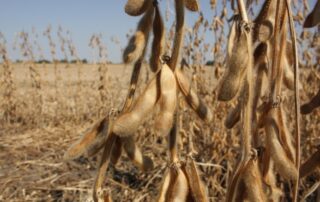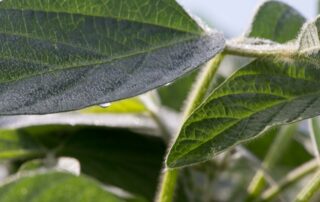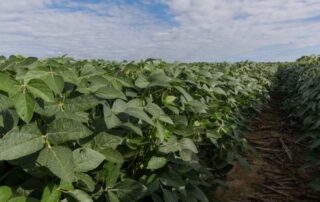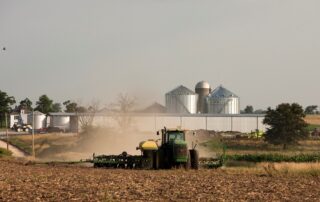Illinois Study Explores Cover Crops to manage Soybean Cyst Nematode
New research funded by the Illinois Soybean Association (ISA) checkoff program is looking at cover crops, including winter wheat, as potential aids in the battle against soybean cyst nematode (SCN). The study builds on previous trials in Illinois and Kentucky that showed promise for use of cover crops to reduce SCN egg populations. In the mid-1990s, a University of Kentucky study indicated no-tilling soybeans into wheat stubble suppressed SCN egg production and reduced counts. Research by former University of Illinois Extension educator Mike Plumer also documented SCN egg reductions following grass cover crops. “These were limited trials, but if [...]
Will soybeans respond to sulfur?
Sulfur (S) is becoming a more deficient nutrient, following phosphorus and potassium. Alfalfa and corn producers are already adding sulfur into their fertility program. Should we be including sulfur in our fertility program for high yield soybeans? Sulfur deficiency symptoms include stunted plants; pale green color indicating nitrogen deficiency except chlorosis is apparent on upper leaves while nitrogen deficiency appears first in lower, older leaves. Sulfur has become more important as a limiting nutrient in crop production in recent years. These include higher crop yields that require more S, less S impurities in modern fertilizers, less use of pesticides [...]
10% Cover Crop Challenges
This article was originally published on Wallaces Farmer. There is no magic recipe for your cash crops. They require trial, error and a great deal of attention. Cover crops are the same way! There is not a prescription. But once you understand the guiding principles and strategic mindset for your cover cropping plan, you’ll achieve much greater success! Our 10% challenge is for: farmers trying cover crops for the first time. farmers looking to take their cover crops to the next level. consultants, trainers or educators seeking a specific plan for their clients. Mindset Matters Treat your cover crops like your cash crops™. It is [...]
WEBINAR: What We’ve Learned from Nitrogen-On-Beans Research
Tim Smith from Cropsmith and Fred Below, Ph.D., from the University of Illinois, discuss their research on applying nitrogen on soybeans, when it makes sense to use it, the optimal timing and application rates and what role soil plays in providing additional nitrogen. Nitrogen Fixation Nodules on the soybean root system Nodules enclose nitrogen-fixing bacteria Active nodules are pink inside Symbiotic Association Both parties benefit; the bacteria in the nodules receive sugar from the plant and the nodules give the plant nitrogen Temperature, soil acidity, water availability and soil aeration can all have a huge impact on nodule activity [...]
Reading a Soil Test Report
Reading a soil test report is a good skill to have, even if someone else is writing recommendations. When a soil sample is submitted to a commercial laboratory they usually analyze pH (water and buffer), organic matter, phosphorus, potassium, calcium and magnesium. And, if requested, they will run sulfur, nitrate and micronutrients including boron, copper, iron, manganese and zinc. Water pH: This is a measurement of pH in the soil solution. A pH of 7 is neutral. As the pH drops, soil becomes more acidic, whereas if it goes up it becomes more alkaline. When pH drops below 6 [...]
Treating Seed is Even More Important Today
Soybean seed treatment adoption continues to expand and become a more important decision, what has changed? This week I supported a retail customer by meeting with a grower and his 80+ year old father to discuss crop protection plans for the 2018 growing season. During the meeting we started discussing soybean seed treatment products. It was interesting because the father made the comment, “I raised soybeans for nearly 50 years and never planted a treated soybean seed. Now my son is spending twice the amount on soybean seed treatments as I did on the actual soybean seed!” In reaction, [...]
Better Bean Series – Jacksonville, Illinois
On February 1st a large crowd gathered at Hamilton’s in Jacksonville, Illinois, to learn how they could maximize yield and reach the full profitability of soybeans. The event was cosponsored by the Illinois Soybean Association and Burrus® Seed. Here is what they learned: Feed the Bean Soybean fertility is critical for achieving high-yielding soybeans and soybeans should not be left to scavenge from the corn crop. Having adequate pH (6.2 – 6.8) can help maximize nutrient availability. P and K levels should be maintained at proper soil test levels to achieve high-yielding soybeans. Soybean plants meet their nitrogen requirement [...]
Sulfur Availability
Sulfur (S) deficiencies are more common due to less atmospheric deposits, declining organic matter levels and bigger crop yields. It’s time to add sulfur to the list of important nutrients so the “Big 3” now becomes the “Big 4” – nitrogen (N), phosphorus (P), potassium (K) and S. According to the International Plant Nutrition Institute (IPNI), a 50 bu/A soybean crop needs 23 lbs. of S while a 75-bushel crop will need about 30 to 35 lbs. TABLE 1 - Nutrient requirements for 50-bushel soybeans: Requirements N P205 K20 S C Mg Lbs./A 257 48 187 23 49 19 [...]
How Often Should I Test My Soil?
What is your approach to soil sampling? How often you should sample? Many times, through the years, I have explained the history of soil testing in agriculture and its evolution as an approved farming practice. I usually begin by asking the question, “When did soil testing as we know it today, first begin?” Followed by, “In the beginning, what did farmers generally test for?” And finally, “What do we typically test for today?” History of Soil Testing Well, let’s start out with a bit of a history lesson. Soil testing can be traced back to early 1920s and, to [...]
Food for Thought
In two months both your physical and mental activities will turn to focusing on planting your 2018 soybean crop, so now is the time to ensure your operation is maximizing its opportunities. Diligent preparation is needed so you don’t allow a lack of fertility and an improper pH to hinder your success before the first seed ever goes in the ground. Additionally, it is no secret that corn may not be the “king” of the castle anymore and relying on its unused fertility leftovers is no longer a sound management decision. Soybean fertility management must be a forethought and [...]












 and then
and then